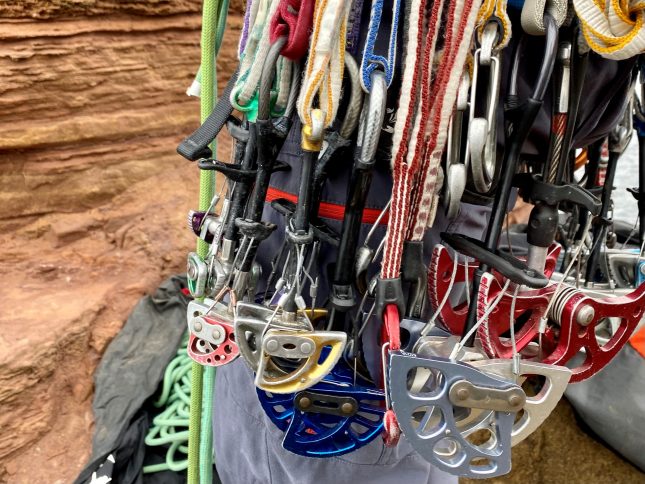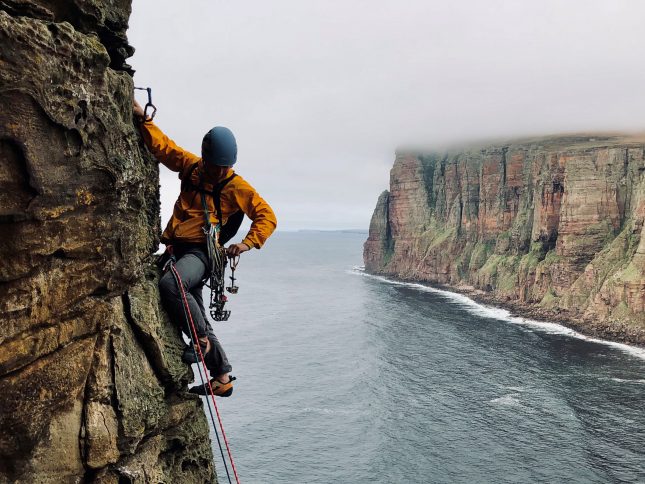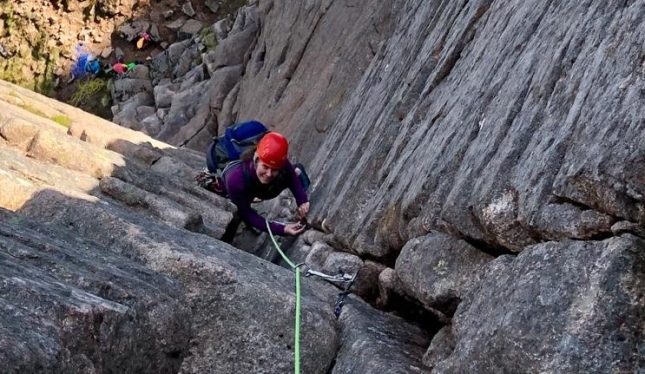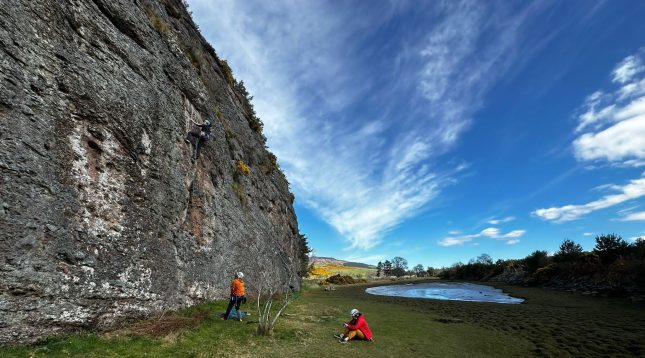Racking Up: Choosing Climbing Gear
Wondering how to kit your rack out with the right gear for your climbing ambitions? Senior Instructor Alex Parmenter shares some top tips for choosing climbing gear to suit the routes you’re aspiring to.
Want to build your confidence and develop your climbing skills? Whatever goal you have in mind, whether it’s learning to lead, pushing your grade, or getting more enjoyment out of your climbing, check out our full range of rock climbing courses to benefit from personalised coaching delivered by an expert Glenmore Lodge Instructor.
When I think back to when I started leading trad routes around 30 years ago, choosing climbing gear to clip on to your harness for a route seemed a simpler process than it is today.
Back then, carabiners tended to have a more generic design. These were often over engineered to be ‘bomb proof’ in nature and covered many bases. There was less choice when it came to pieces of protection and more of a ‘one rack fits all routes’ culture. Certainly that was true where I was climbing at the time.
New developments & challenges
Skip forwards 30 years, and kit has become more specialised. Cutting edge engineering has driven development down new routes with increased options. Ease of use, lightweight solutions, burly kit for rescues, and more. This has pros and cons: it means that you can build a rack highly specialised towards a particular task, that delivers flawless performance. But if that kit is used in the wrong way for the wrong task, situations can unravel quickly or kit might wear out unexpectedly fast. It also has the problem of potentially adding significant cost to the climber if they want to take on a broad range of climbing experiences and feel they effectively need to purchase different kit for different situations.
So, how do you adapt your rack by choosing the right climbing gear for different challenges? I guess the main divisions would be between sport and trad climbing (Winter Climbing is another subject in itself!). Trad climbing is where I spend most of my time on rock so let’s start there.
.

.
Trad Climbing Gear
The biggest difference between my trad rack of 30 years ago and now is the weight. These days the load that I am hauling up any given pitch is significantly reduced. This means I can enjoy increased comfort, and some performance gains.
Caribiners
Cutting edge engineering has shaved grams off carabiners; both through changing the cross-sectional shape of the carabiner as well as the size of the carabiner as a whole. I mention this as changing the cross-sectional shape feels like a big win, saving me weight for very little performance cost. However reducing the overall size of the carabiner can make things more fiddly when it comes to actually using them! This makes the biggest difference in winter when we are operating with thick gloves on. As I don’t want to have separate large carabiners that only get used in winter, I personally do not buy the super small ones. I’d rather accept the trade off of carrying more weight in favour of ease of use all year round.
Screwgates
The correct noun for a group of screwgates is known in the instructional world as an ‘assessment’ of screwgates. This is because it will only be on Mountaineering and Climbing Instructor assessments that so many will gather together in one place. In reality, there are many situations where wiregate carabiners will safely do for a fraction of the weight and bulk of a screwgate. You will of course need a few screwgates along for the ride in key roles at the belay.
.

.
Slings
Slings have also shed the pounds over my climbing journey. For my trad rack I pretty much exclusively use skinny dyneema slings, which are easy to use, very lightweight and take up less space in your bag on the walk to the crag. There are some health warnings however when it comes to dyneema. Probably the most relevant would be furry slings (i.e. well used slings that develop a furry like surface), which means they are weakened significantly and should be replaced.
Quickdraws
For trad climbing, I really value having a variety of lengths of quickdraw and have some set up in an extendable format on 60cm sling folded into thirds. This allows them to be clipped short or long and helps reduce rope drag. Obviously for longer pitches I carry more, for shorter ones less.
Cams, hexes & nuts
Regarding the gear that you’re going to place in the rock, choices have increased and can be confusing. It is a tricky topic as the rock type you are climbing on will influence which gear will work best.
Where I live in the Cairngorms, cams are king. The rock is grippy and there are many parallel cracks. I do recommend carrying some very small cams. I think many folks think small ones are just for hard routes, but they often make even easy routes safer. It’s common for me to carry a full set of cams, even to the point of not carrying hexes at all. I tend to reserve them for winter when it can be harder to get a good cam placement due ice coating the sides of many cracks. However there are some rock types (particularly smooth ones) where cams can be prone so sliding out and that’s when hexes make a reappearance.
.

.
There are a dizzying variety of nuts these days on the market. For me, I keep it simple with two full sets for longer pitches or multi-pitches with a few micronuts thrown into the small set. The new(ish!) kid on the block are offsets, these are designed to fit better in slightly flared cracks. They can feel great when you get a sinker and offer solid placements where none existed before. But the downside is they can be hard to remove.
Sport Climbing Gear
For sport climbing it is ideal to have some burlier kit to deal with repeated falls onto bolts. The carabiners on the quick draws are built to withstand the metal-on-metal grind they experience when clipped to a bolt. The fabric connecting the two carabiners tends to be heavier duty and typically nylon rather than dyneema. This makes them easier to clip and the thick nylon also makes it easier to pull on when resting or trying to make progress to clip the next bolt.
The addition of a clip stick is also useful when it comes to either protecting the first few moves of the climb or when trying to equip a pitch with quickdraws rather than place them on the lead. As we tend to climb on single rope when sport climbing the addition of a brake assisted belay device such as a Petzl Gri-Gri (other brands are available!) can also make life a little easier.
.

.
In Summary
It is a good idea to learn a little about the nature of the gear you are using on your rack, understand its advantages and limitations when choosing the right climbing gear for your goals. Be aware when you can use gear in a variety of circumstances, it may not be ideal but still safe. Be wary of when you are using the kit in a manner for which it wasn’t designed and are asking for trouble. If you are starting out aim for kit that is not too specialised so you don’t need to invest in multiple sets of gear. For the more experienced, splashing some cash on some shiny gadgets may vastly improve your experience in specific situations.
LEARN MORE
ESSENTIAL ROCK CLIMBING KIT ADVICE
Get some top tips on essential rock climbing kit in this blog from Senior Instructor Stuart McAleese
READ HEREROCK CLIMBING COURSES
Check out our full range of rock climbing courses, which offer something for everyone and are delivered by our expert Instructors
EXPLORE COURSESOUR EQUIPMENT PARTNERS
Find out more about the partners who provide our Instructors with the kit to do their jobs every day.
LEARN MORE